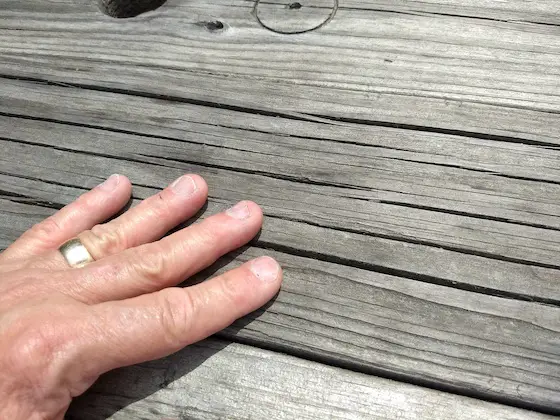Why Does Wood Crack

These pieces of outdoor wood decking show serious signs of neglect. The large cracks allow water to soak deep into the wood. Copyright 2022 Tim Carter
Why Does Wood Crack - It's Water's Fault
Do you own anything made from wood that lives its life outdoors? It could be a stunning deck, perhaps a decorative privacy fence, maybe a pergola, or even a teak table and chair set. I’ve owned all of the above and more over quite a few trips around the sun.
When I was younger, I didn’t think much of the work, time, and expense it required to keep the wood looking like new. But every year as I cleaned and re-sealed one of my outdoor wood things, the work grew more and more tiresome. In many ways all of my outdoor wood possessions were like my three kids when they were young. They also required constant care.
Over the past ten years I finally surrendered to the unrelenting power of the sun and rain. My dock panels and steps leading down to the lake are the only things left I have made from wood. Fortunately I finally discovered a wood sealer that appears to last for four years instead of the normal two I got from every other product. Every other outdoor wood object I owned has been replaced with something that isn’t made from wood.
Wood is Hygroscopic - It Swells & Shrinks
Allow me to share with you why you’ll probably wave the white flag and concede to the forces of Mother Nature at some point in time. It’s important to realize that wood is hygroscopic. This simply means that its size changes in response to the moisture content of the wood. Wood expands when it gets wet and then it shrinks as it dries. This movement, over time, starts to rip the wood apart.
If you look closely at a new piece of milled wood, it’s usually smooth and free from any surface defects. However this appearance is transitory. As soon as you subject untreated wood to frequent wet/dry cycles, you’ll start to see very tiny checking cracks develop. These are tiny hairline cracks in the top surface of the wood.
The next time it rains, these cracks allow the water to penetrate deeper and faster into the wood. This causes even greater expansion pressure between the wood fibers and soon the lignin in the wood fails. Small cracks get bigger and eventually a piece of wood will split in two. Think of how a steel wedge is used to split a piece of firewood. Water does the same exact thing to your wood deck, fence, or teak furniture.
This is why it’s paramount to keep outdoor wood sealed so water doesn’t soak into the wood to make tiny cracks huge cracks as you might see on a neglected fishing pier boardwalk that extends out into the ocean.
UV Light Blasts Wood Apart
If you think water is bad for wood, wait until you layer on top of it the punishing ultraviolet (UV) rays of the sun. A small percentage of the sun’s UV rays contain active photons. When photons hit an object traveling 186,000 miles per second, imagine a microscopic nuclear explosion.
Photons are so powerful they can break atomic bond of metals. Have you ever wondered why the corrugated metal roofs you see on barns and other agricultural buildings are rusty? Do you know what the roof looked like when new? They were shiny silver like a new galvanized garbage can. The fresh zinc coating can be blinding in the sun.
UV Light Removes Zinc
But each day when photons hit the zinc, they break bonds and then the next rain washes the zinc from the roof. Eventually there’s no zinc protective coating left and the exposed steel begins to rust. The same thing happens with copper flashings on roofs. Have you ever noticed how the roof surface below a copper flashing looks new and is mold-free? It’s because copper is a natural biocide and each rainfall transfers copper from the flashing to the roof surface.
Why is My Wood Fuzzy?
Knowing this, imagine how destructive UV light is to your wood! Wood is so much more fragile than zinc or copper. The UV rays blast apart the lignin that holds the wood fibers together. This is why after you wash your deck, fence, pergola, or furniture it’s fuzzy. The fuzz is wood fibers that are just barely hanging on like your child’s tooth that’s about to fall out. You have to allow the wood to dry, then go through the painstaking process of sanding it to get the wood smooth again.
Avoid Clear Wood Sealers
You can minimize UV damage to wood by using outdoor wood sealers that have a fair amount of pigment in them. The pigment acts like sunscreen or a sacrificial anode in a water heater. The pigment is a shield and gives up its life so the UV rays, photons, don’t make it to the wood. But you know how this ends. Your deck color starts to fade just as zinc washes off the galvanized roof panels. Soon there’s not enough pigment left and the UV rays can get to the wood.
Paint is the ultimate protector for wood, but the issue is it will eventually fail. Because your wood is hygroscopic and expands and contracts at a greater rate than the paint, the paint eventually cracks and peels. Then you have an even bigger mess on your hands. Now you know why I eat lunch each summer day with my feet resting on my composite deck while enjoying my food that’s on a wonderful aluminum table and my posterior is parked in a matching aluminum chair!
Column 1467
One Response to Why Does Wood Crack